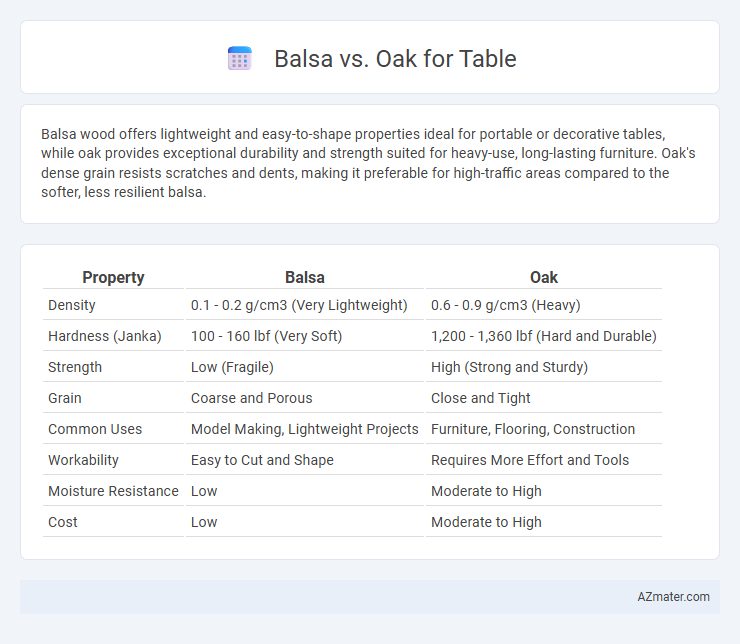Balsa wood offers lightweight and easy-to-shape properties ideal for portable or decorative tables, while oak provides exceptional durability and strength suited for heavy-use, long-lasting furniture. Oak's dense grain resists scratches and dents, making it preferable for high-traffic areas compared to the softer, less resilient balsa.
Table of Comparison
| Property | Balsa | Oak |
|---|---|---|
| Density | 0.1 - 0.2 g/cm3 (Very Lightweight) | 0.6 - 0.9 g/cm3 (Heavy) |
| Hardness (Janka) | 100 - 160 lbf (Very Soft) | 1,200 - 1,360 lbf (Hard and Durable) |
| Strength | Low (Fragile) | High (Strong and Sturdy) |
| Grain | Coarse and Porous | Close and Tight |
| Common Uses | Model Making, Lightweight Projects | Furniture, Flooring, Construction |
| Workability | Easy to Cut and Shape | Requires More Effort and Tools |
| Moisture Resistance | Low | Moderate to High |
| Cost | Low | Moderate to High |
Introduction to Balsa and Oak Wood
Balsa wood, known for its exceptionally low density and lightweight structure, offers excellent buoyancy and ease of shaping, making it ideal for model making and lightweight furniture. Oak wood, a hardwood prized for its strength, durability, and attractive grain patterns, is commonly used in high-quality furniture and flooring due to its resistance to wear and moisture. The choice between balsa and oak for tables depends on the requirement for either lightness and flexibility or robustness and longevity.
Wood Density and Strength Comparison
Balsa wood has an exceptionally low density, averaging around 160 kg/m3, making it one of the lightest woods available, whereas oak has a much higher density, typically between 700-900 kg/m3, contributing to its substantial weight and durability. In terms of strength, oak excels with high hardness and compressive strength, often reaching 6,000 psi, making it ideal for robust table construction, while balsa's strength is significantly lower, approximately 170 psi, limiting its use to lightweight or decorative tables. Oak's superior density and mechanical properties provide enhanced stability and wear resistance, whereas balsa's lightweight nature offers ease of handling but reduced load-bearing capacity.
Aesthetic Differences: Grain and Color
Balsa wood features a light, creamy color with a fine, uniform grain that creates a smooth and subtle aesthetic, ideal for minimalist or modern table designs. Oak wood presents a richer, more pronounced grain pattern with warm golden to reddish-brown hues, adding character and a classic, rustic appeal to tabletops. The contrasting textures and tones of balsa and oak significantly influence the visual impact and style of the finished furniture piece.
Durability and Longevity
Oak is significantly more durable than balsa, boasting a high-density hardwood structure that resists dents, scratches, and wear over time, making it an ideal choice for long-lasting tables. Balsa, known for its lightweight and softness, lacks the hardness needed for furniture subjected to frequent use, leading to quicker surface damage and reduced longevity. Choosing oak guarantees superior strength and durability for a table designed to endure years of daily use, while balsa is better suited for lightweight, decorative purposes rather than functional furniture.
Workability and Ease of Crafting
Balsa wood is renowned for its exceptional workability due to its lightweight and soft texture, making it easy to cut, shape, and sand, ideal for crafting intricate table details. Oak, in contrast, is a dense hardwood with a coarse grain that requires more effort and sharper tools to work with but offers greater durability and a robust finish in table construction. Craftsmen often prefer balsa for prototype or decorative tables, while oak is selected for sturdy, long-lasting furniture pieces.
Weight and Portability Factors
Balsa wood is significantly lighter than oak, with a density around 160 kg/m3 compared to oak's 700 kg/m3, making it ideal for portable tables that require easy handling and transport. The low weight of balsa enhances mobility without sacrificing basic strength, whereas oak's heaviness contributes to durability and sturdiness but limits portability. For applications prioritizing weight and ease of movement, balsa tables offer superior convenience, while oak suits stationary use due to its weight and robustness.
Cost and Availability
Balsa wood is significantly more expensive than oak due to its lightweight, fast growth, and limited supply primarily in South America, whereas oak is widely available globally and more cost-effective for table construction. Oak's abundance and durable hardwood properties make it a preferred choice for affordable, sturdy tables, while balsa's rarity and softness limit its practicality despite its premium price. For budget-conscious buyers, oak offers a more accessible and economically viable option compared to the high cost and lower availability of balsa wood.
Environmental Impact and Sustainability
Balsa wood has a significantly lower density and faster growth rate, making it a highly renewable resource with minimal environmental impact compared to oak. Oak trees require decades to mature and involve more intensive harvesting processes, contributing to greater carbon emissions and habitat disruption. Selecting balsa for tables supports sustainability goals through reduced deforestation and enhanced carbon sequestration, whereas oak's durability often comes at a higher ecological cost.
Suitability for Different Table Types
Balsa wood, known for its lightweight and softness, is ideal for decorative or lightweight tables that do not require high durability, such as craft or side tables. Oak, with its dense grain and exceptional strength, is highly suitable for dining tables, workbenches, and heavy-use furniture where durability and load-bearing capacity are crucial. Choosing between balsa and oak depends on the table's function, with oak preferred for longevity and heavy use, while balsa suits applications prioritizing ease of handling and aesthetic detail.
Conclusion: Best Choice for Your Table
Oak's superior strength and durability make it the ideal choice for long-lasting tables exposed to regular use and weight-bearing needs. Balsa's lightweight and softness suit decorative or temporary tables but lack the resilience required for everyday furniture. Choosing oak ensures longevity and structural integrity, while balsa offers ease of shaping and portability for specific design preferences.

Infographic: Balsa vs Oak for Table
 azmater.com
azmater.com